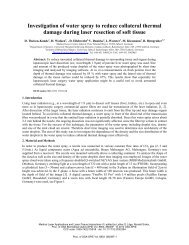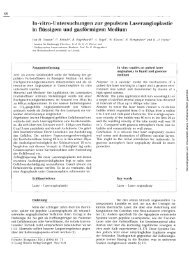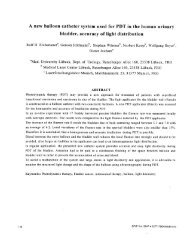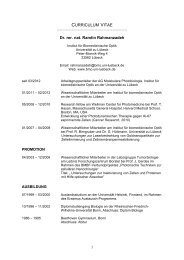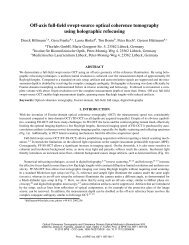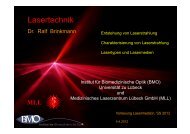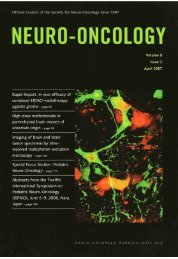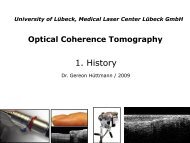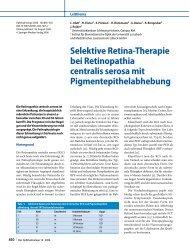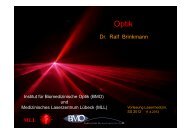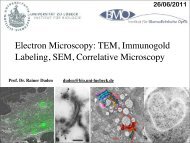Invited p aper Mechanisms of femtosecond laser nanosurgery of ...
Invited p aper Mechanisms of femtosecond laser nanosurgery of ...
Invited p aper Mechanisms of femtosecond laser nanosurgery of ...
Create successful ePaper yourself
Turn your PDF publications into a flip-book with our unique Google optimized e-Paper software.
VOGEL et al. <strong>Mechanisms</strong> <strong>of</strong> <strong>femtosecond</strong> <strong>laser</strong> <strong>nanosurgery</strong> <strong>of</strong> cells and tissues 1021Here 〈x〉 represents the integer part <strong>of</strong> the number x, K() andE() denote elliptic integrals <strong>of</strong> the first and second kinds, andΦ() denotes the Dawson probability integral∫ zΦ(z) =0exp ( y 2 − x 2) dy . (6)The Keldysh parameter γ and the effective ionization potential˜∆ for creating an electron–hole pair in condensed matterexhibiting a band structure are given byγ = ω √cε0 m∆and ˜∆ = 2 √ ( )1 + γe 4Iπ ∆ 21E √ . (7)γ 1 + γ2Some authors [110, 113, 115, 120] used the expression in (1)for the ionization potential <strong>of</strong> individual atoms to describephotoionization in condensed matter instead <strong>of</strong> the more adequateequation (7), which Keldysh derived for solids. Forγ ≫ 1, (5) reduces to the expression for multiphoton ionizationused in [81, 110], and the ionization potential can beapproximated by the band-gap energy ∆. Under these circumstancesthe photoionization rate shows an intensity dependenceproportional to I k , k representing the number <strong>of</strong>photons required to cross the band gap.Figure 2 shows the calculated ionization rate for 780 nmas a function <strong>of</strong> the Keldysh parameter calculated with thecomplete model in (5) and with various approximations. Forvalues γ ≪ 1, the Keldysh multiphoton approximation predictsphotoionization rates that are too low by several orders <strong>of</strong>magnitude, while the predictions <strong>of</strong> Kennedy’s multiphotonapproximation [81, 110] are by several orders <strong>of</strong> magnitudetoo large.As soon as free electrons exist in the interaction volume,they gain kinetic energy through inverse Bremsstrahlung absorption<strong>of</strong> photons and can generate further free electronsthrough impact ionization once their energy exceeds the criticalenergy described by (2). As explained above, we assumethat the average gain <strong>of</strong> kinetic energy by each electron requiredto cause an impact ionization event is E = (3/2) ˜∆.Theionization rate per electron participating in the cascade is thenFIGURE 2 Nonlinear photoionization rate for water at λ = 780 nm calculatedwith the complete Keldysh model (pink), with Keldysh’s approximationsin the tunnel limit (green) and the multiphoton limit (violet), and withKennedy’s approximation in the multiphoton limit (blue) [81, 110]given by [110][1 e 2 τη =ω 2 τ 2 + 1 cn 0 ε 0 m c (3/2) ˜∆ I − m cω 2 ]τ, (8)Mwhere τ is the time between collisions, c the vacuum speed <strong>of</strong>light, and n 0 the refractive index <strong>of</strong> the medium at frequencyω. The masses <strong>of</strong> the electron and the water molecule are mand M, respectively. For large irradiances, the cascade ionizationrate is proportional to I.Two aspects must still be considered to accurately determinethe cascade contribution to the free-electron density.First, at least one free ‘seed’ electron produced by photoionizationis required for the start <strong>of</strong> the cascade. Therefore,cascade ionization is only considered if there is at leasta 50% probability <strong>of</strong> having this start electron in the focalvolume. Second, it must be taken into account that inverseBremsstrahlung absorption requires a finite time τ ion = τn,which is determined by the mean free time τ (1.7fs[118]) betweenelectron/molecule collisions and the number n <strong>of</strong> photonsthat must be absorbed to gain sufficient energy. Therefore,the contribution <strong>of</strong> cascade ionization at time t must beevaluated using the electron density created at time t ret = t −t ion . A first-order approximation <strong>of</strong> this retardation <strong>of</strong> the cascadeleads to the expression( ) { ηdϱc=1+ηt retϱ c for ϱ c V ≥ 0.5 ,(9)dt 0 forϱcascc V < 0.5 .Free electrons are lost in the interaction volume by diffusionout <strong>of</strong> the volume V and through recombination. The focalvolume was assumed to be ellipsoidal, which corresponds toillumination <strong>of</strong> the rear <strong>aper</strong>ture <strong>of</strong> the microscope objectivewith a plane wave, as will be discussed in Sect. 3.1. Thus,V = (4/3)πa 2 b,wherea and b are the short and long half-axes<strong>of</strong> the ellipsoidal free-electron distribution described by (16),below. The resulting (negative) ionization rate due to diffusionis [110, 124]( ) dϱc=− τE avdt diff 3mΛ 2 × ϱ c =− τ5 [˜∆ 66m c a 2 + 2 ]b 2 × ϱ c , (10)where E av is the average kinetic energy <strong>of</strong> the free electronsand Λ is the characteristic diffusion length. Free electronsproduced by impact ionization possess, on average, a startenergy <strong>of</strong> (1/2) ˜∆ and produce another free electron throughcollisional ionization when they reach a kinetic energy <strong>of</strong>2 ˜∆. Thus, their mean kinetic energy is (5/4) ˜∆, leading tothe expression on the right-hand side <strong>of</strong> (10). For the recombinationrate, we used an empirical value that was determinedby Docchio through inspection <strong>of</strong> the decay <strong>of</strong> theplasma luminescence [125]:( ) dϱc=−2 × 10 −9 cm 3 /s × ϱ 2 cdt. (11)recIn reality, recombination <strong>of</strong> free electrons in water is not a onestepprocess but consists in hydration <strong>of</strong> the electron withinabout 300 fs and subsequent decay <strong>of</strong> the hydrated state thathas an average lifetime <strong>of</strong> ≈ 300 ns [103].



